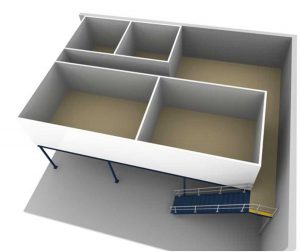How to Choose the Best Industrial Mezzanine Floor Design
If you're a business owner in Australia looking to optimise your warehouse or factory space, then you're more than likely familiar with the challenges of maximising your available floor space.
That's where industrial mezzanine floors come in, offering an excellent solution to expand your storage, manufacturing, or office space while still maintaining a safe and productive work environment.
But with so many different types of mezzanine floor designs and options available, it can be difficult to determine which one is right for your business.
In this article, we'll explore how to choose the best industrial mezzanine floor design to meet your unique needs and requirements.
Steps to choose the best industrial mezzanine floor design
1. Understand the purpose of your mezzanine
Before starting the design process for your mezzanine, it's important to understand the purpose of the space you're creating.
Every business has unique needs, and the purpose of your mezzanine will depend on your specific requirements, whether it be storage, production, office space, or something else.
Understanding the purpose of your mezzanine will help you to create a design that's both efficient and effective, ensuring that your new space is designed to meet the needs of your business.
Mezzanine purposes
Here are some common industrial and commercial purposes for mezzanine flooring:
- Storage: A mezzanine designed for storage purposes can help you maximise your available floor space by adding additional storage capacity. This can be particularly useful for businesses with a lot of inventory or bulky items that require a lot of space.
- Production: Mezzanines designed for production purposes can provide a designated area for manufacturing processes, conveyor belts, or assembly lines. This can help to increase productivity and create a more organised and efficient workspace.
- Office space: A mezzanine designed for office space can provide additional workspace for your employees. This can be particularly useful for businesses that are expanding but may not have the budget or space for a full expansion.
- Retail: Mezzanines designed for retail purposes can be used to showcase products, create a unique shopping experience, or add additional retail space.
2. Determine the Load Capacity Required
Load capacity refers to the maximum weight that the mezzanine floor can support without compromising the safety and integrity of the structure. Determining load capacity is a critical factor in the design of an industrial mezzanine floor as it ensures that the floor can support the weight of all items, equipment, and personnel that will be using the space.
Several factors determine the load capacity of a mezzanine floor, including the type of materials used, the thickness and quality of the steel, the design of the structure, and the way the weight is distributed across the floor.
Not considering the load capacity required for your specific application can lead to serious safety risks, such as collapse or damage to the structure, as well as damage to the products and equipment stored on the mezzanine.
Load capacity factors
Here are some factors to consider when determining the load capacity required for an industrial mezzanine floor:
- Type of products or equipment being stored: The weight of the products or equipment being stored on the mezzanine floor will significantly impact the load capacity required. Heavy machinery or equipment, for example, will require a higher load capacity than a storage area for shelving, small boxes, and containers of stock.
- Intended use of the mezzanine: The purpose of the mezzanine floor will also impact the load capacity required. If the mezzanine is designed for heavy machinery, it'll need to support higher loads than a mezzanine used for storage or personnel only.
- Frequency of use: The frequency of use can also affect the load capacity required. If the mezzanine floor will be used frequently or on a daily basis, it must have a higher load capacity than a mezzanine used less often.
3. Check the height requirements of your storage area
When it comes to the mezzanine floor design, understanding the height requirements of your storage area is crucial. Height requirements refer to the minimum and maximum vertical space needed for storage or equipment to fit comfortably within the area.
Failing to consider height requirements can result in a poorly designed mezzanine that doesn't meet the needs of the business.
Different types of height requirements
Here are some different types of height requirements to consider when designing a mezzanine floor:
- Building codes and regulations: Every city and state has its own regulations regarding building heights. It's important to ensure that your mezzanine design meets all the necessary codes and regulations.
- Equipment height: If your storage area requires the use of tall machinery or equipment, you'll need to design the mezzanine with enough clearance to accommodate them.
- Product height: If you plan to store large or tall products on the mezzanine, you'll need to ensure that the height of the mezzanine provides enough clearance.
- Ceiling height: The ceiling height of your facility will also impact the height requirements of your mezzanine design. If the ceiling is low, your mezzanine may need to be lower in height to comply with building codes and regulations.
4. Decide on Materials for Your Mezzanine
Choosing the right materials for your mezzanine is crucial to ensure the safety and longevity of the structure. There are several factors that will determine the right material options for your mezzanine, including load capacity, desired lifespan, maintenance requirements, and budget.
When it comes to load capacity, heavier loads will require stronger materials such as steel or reinforced concrete. For a longer lifespan, materials such as steel and aluminium are all good options due to their durability and resistance to rust and corrosion.
Maintenance requirements can also play a role in material choice, as some materials will require more upkeep than others. Ultimately, it's important to balance all potential factors to determine the best material for your mezzanine.
Different types of mezzanine materials
Here are some common materials used for mezzanine floors:
- Steel: The most common material for mezzanine floors. It's strong, durable, and can be designed to meet various load capacity requirements.
- Concrete: Ideal for heavy-duty loads and high-traffic areas, but a more expensive option compared to steel.
- Wood: Provides a more traditional look and is suitable for lighter loads, but is less durable than steel or concrete.
- Fibreglass grating: Corrosion-resistant, low maintenance, and slip-resistant, making it suitable for harsh environments.
- Aluminium: Lightweight and corrosion-resistant, but not as strong as steel and not recommended for heavy-duty loads.
- Composite decking: Made of a combination of wood fibres and plastics. It's durable, low maintenance, and environmentally friendly.
- Open steel grating: Provides good ventilation, easy drainage, and slip resistance, but is not suitable for small items or wheeled equipment.
5. Plan your Safety Features
When designing a mezzanine floor, safety should be a top priority. There are several factors to consider to ensure the safety of workers and the integrity of the structure.
One of the most important factors to consider is the intended use of the mezzanine floor. A mezzanine used for storage will have different safety requirements compared to one used for production or assembly.
Other factors that determine the necessary safety features include the height of the mezzanine, the type of load it'll be supporting, the type of access required, and any regulatory requirements.
Different types of safety features
There are several safety features that can be incorporated into the design of the mezzanine floor, including:
- Handrails and guardrails: These are essential for preventing falls from the edge of the mezzanine.
- Kickplates: These help prevent items from falling off the mezzanine and onto the floor below.
- Safety gates: These provide safe access points to the mezzanine and can be designed to close off areas when not in use.
- Fire protection: Depending on the use and location of the mezzanine, it may be necessary to include fire suppression systems, smoke detection, and sprinklers.
- Lighting: Proper lighting is important for visibility and safety.
- Non-slip flooring: Slip-resistant flooring can help prevent slips and falls.
- Signage: Clear signage can help prevent accidents and ensure safe usage of the mezzanine floor.
What kind of mezzanine floor design is right for my business?

Designing a mezzanine floor involves considering several crucial factors such as purpose, load capacity, height requirements, materials, and safety features.
By carefully assessing these factors and working with a team of experts, you can create a mezzanine floor that not only maximises your available space but also enhances your operation's safety and efficiency.
Whether you're looking to expand your storage capacity or create additional office space, a well-designed mezzanine floor can be an excellent solution for your business needs.
Building a mezzanine | Work with the best mezzanine builders in Australia
If you're looking for more information, or you're ready to take the next steps and install a mezzanine floor on your business's work site, look no further than Advanced Warehouse Structures.
With over 15 years in operation and over 30 years of staff experience in the industry, our expert team can find the perfect mezzanine solution for your business. We even take custom projects to fit all kinds of storage areas, offices, and warehouses down to the smallest details.
From initial consultation and design to final installation and sign-off, we're committed to delivering high-quality services and solutions that meet the needs of every single client all across Australia. We've created structures for clients and businesses in several locations, from Sydney, Newcastle, and regional NSW to Melbourne, Brisbane, and Adelaide.
Get in touch with us today to get a free quote and design! The AWS team will work alongside you to produce a short lead time and build the best storage system or mezzanine floor level for your building.
